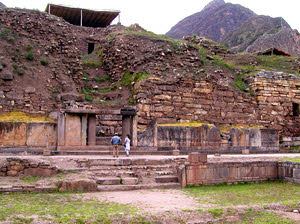Anthropology
Related: About this forumArcheologists discover two stone sculptures at Chavin de Huantar in Ancash
Archeologists discover two stone sculptures at Chavin de Huantar in Ancash
2 Hours ago
by Diego M. Ortiz
The sculptures are in the shape of decorative heads and weigh around 250 kg.

Two stone sculptures believed to date back to 1200-1500 B.C. were discovered at the Chavin de Huantar archeological site in Huaraz, according to the team led by Dr. John Rick, an archeologist from the United States.
The sculptures, which are in the shape of decorative heads, measure approximately 103 centimeters in length and weigh around 250 kilograms. The heads were found approximately two meters from one another.
These were not the first such heads discovered in the Chavin Huantar site. In 1920 an archeologist named Julio C. Tello found a large number of “cabezas clavas” that were buried inside the façade of the temples. Many of them were swept away and lost in a flood that covered the site in 1940.
Today, only one of these ancient head sculptures can be found at the original archeological site. More than 100 sculpted heads have been sent to the National Chavin Museum.
“The last time we found a Chavin head was back in 2006. Before that we found one in 2004, and before that it had been 60 years,” Rick explained.
More:
http://www.peruthisweek.com/news-archeologists-discover-two-stone-sculptures-at-chavin-huantar-in-ancash-100745
Judi Lynn
(160,424 posts)The Chavín were a civilization that developed in the northern Andean highlands of Peru from 900 BC to 200 BC. They extended their influence to other civilizations along the coast.[1][2] The Chavín were located in the Mosna Valley where the Mosna and Huachecsa rivers merge. This area is 3150 meters above sea level and encompasses the quechua, jalca, and puna life zones.[3]
The most well-known archaeological site of the Chavín era is Chavín de Huántar, located in the Andean highlands north of Lima. It is believed to have been built around 900 BC and was the religious and political center of the Chavín people.[3] It has been designated a UNESCO World Heritage Site.
Achievements
The chief example of architecture is the Chavín de Huántar temple. The temple's design shows complex innovation to adapt to the highland environments of Peru. To avoid the temple's being flooded and destroyed during the rainy season, the Chavín people created a successful drainage system. Several canals built under the temple acted as drainage. The Chavín people also showed advanced acoustic understanding. During the rainy season, water rushes through the canals and creates a roaring sound and creates a noise like a jaguar, a sacred animal. The temple was built of white granite and black limestone, neither of which is found near the Chavín site. This meant that leaders organized many workers to bring the special materials from far away rather than use local rock deposits.
The Chavin civilization also demonstrated advanced skills and knowledge in metallurgy, soldering, and temperature control. Chavin used early techniques to develop refined gold work. The melting of metal had been discovered at this point and was used as a solder.[4]
The people domesticated camelids, such as llamas. Camelids were used for pack animals, for fiber, and for meat. The Chavin produced ch'arki, or llama jerky.[5] This product was commonly traded by camelid herders and was the main economic source of the Chavin people. Chavin people also successfully cultivated several crops, including potatoes, quinoa, and maize. They developed an irrigation system to assist the growth of these crops.[6]
More:
http://en.wikipedia.org/wiki/Chav%C3%ADn_culture
[center] 



 [/center]
[/center]
Andean South America Culture Area
Chavin Culture
http://people.wku.edu/darlene.applegate/newworld/webnotes/unit_4/chavin.html
a la izquierda
(11,791 posts)Judi Lynn
(160,424 posts)in U.S. American schools.
So glad to hear you are taking pains to correct this horrendous, inexcusable deficit.